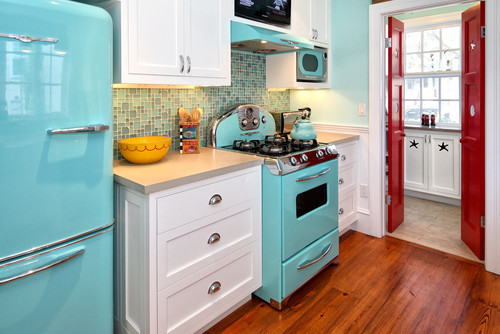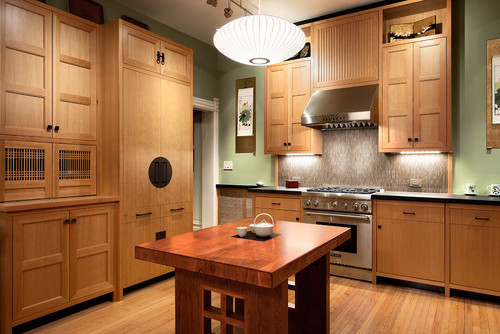Best and Worst Kitchen Appliances, Countertops, Flooring and More
 (Photo: Thinkstock)
(Photo: Thinkstock)
Got a bottomless budget for your dream kitchen? You could pay for the sleekest pro-style appliances the most luxurious stone countertop, and the trendiest hardwood flooring and still end up paying again to fix things that break down, crack, or dent. Or you could use our advice to make every dollar count by sidestepping high-priced pitfalls in the first place.
And if your budget is more in the $15,000-to-$30,000 range that most homeowners spend on renovations, relax: You can have a beautiful kitchen that's functional and efficient, and only looks expensive, like the example here. It combines semi-custom cabinets, quartz countertops, and vinyl flooring to achieve an urban sophistication befitting its city setting.
Appliances
 KitchenAid KDRU763V $6,000 (Photo: Consumer Reports)High End: A pro-style, 36-inch range with high-Btu burners; a built-in refrigerator with panels that match the surrounding cabinetry; and whisper-quiet dishwashers are expected in today's luxury homes. "If buyers walk into a high-end home and see apartment-grade or even midrange appliances, they're going to wonder what else is missing from their wish list," says Jim Hamilton, regional Vice President of the National Association of Realtors.
KitchenAid KDRU763V $6,000 (Photo: Consumer Reports)High End: A pro-style, 36-inch range with high-Btu burners; a built-in refrigerator with panels that match the surrounding cabinetry; and whisper-quiet dishwashers are expected in today's luxury homes. "If buyers walk into a high-end home and see apartment-grade or even midrange appliances, they're going to wonder what else is missing from their wish list," says Jim Hamilton, regional Vice President of the National Association of Realtors.
Separate steam ovens, which can cost several thousand dollars and are pitched as a healthful way to prepare vegetables, fish, and even desserts, are a popular trend in high-end appliances. "Restaurants have been steaming food for years. Now the technology is finally coming to the residential market," says Laurie Haefele, a designer-architect in Santa Monica, CA. Some models combine steam and convection cooking to lock in moisture while browning foods that require it.
But not all high-end appliances deliver. Though we recommend KitchenAid dual-fuel ranges, its electric and gas models have been repair-prone, as have Jenn-Air's electric ranges, wall ovens, and cooktops. And some of Viking's Professional-series built-in refrigerators are at the bottom of our ratings.
 Samsung FTQ307NWGX $1,700 (Photo: Consumer Reports)
Samsung FTQ307NWGX $1,700 (Photo: Consumer Reports)
For Less: Many mainstream brands have upped their styling with "faux pro" features, including beefy controls and a stainless-steel finish. And they equal or surpass their pricey counterparts when it comes to cooking and reliability. GE's $1,500 Profile PGB910SEM has sleek styling, and it's our top-performing gas range. Or consider an induction range or cooktop,which uses electromagnetism to deliver pinpoint heating and control. Among refrigerators, cabinet-depth models offer the streamlined look of built-ins for thousands less.
Flooring
High End: Wood has warmth and elegance and can be used in adjacent rooms, creating a seamless flow between spaces. "Plus if you drop a teacup on a wood floor, the cup has a fighting chance," says Kelly Stewart, a National Kitchen & Bath Association-certified kitchen designer in Stamford, CT.
 Mullican St. Andrews Solid Oak Strip 10930, $6.30 per sqft (Photo: Consumer Reports)Antique wood floors, milled from timbers reclaimed from centuries-old buildings, have character, but they've been particularly prone to wear and tear in our tests. Performance-wise, you're better off with solid wood flooring with a factory finish, which costs more up front than unfinished flooring but lasts longer and eliminates the mess of on-site finishing.
Mullican St. Andrews Solid Oak Strip 10930, $6.30 per sqft (Photo: Consumer Reports)Antique wood floors, milled from timbers reclaimed from centuries-old buildings, have character, but they've been particularly prone to wear and tear in our tests. Performance-wise, you're better off with solid wood flooring with a factory finish, which costs more up front than unfinished flooring but lasts longer and eliminates the mess of on-site finishing.
Even the most durable wood floors are no match for heavy traffic, especially if it includes sandy shoes and dog's claws. Durable stones such as granite and quartzite offer more protection and a sense of permanence. "People subconsciously associate stone with stability underfoot, so its a natural choice for flooring," says New York City architect Leonard Kady.
 Quick-Step Perspectives Ansel Oak UF1259, $4 per sq ft (Photo: Consumer Reports)For Less: Engineered wood flooring, which has a veneer or real wood over substrate, can be floated over the subfloor, saving on installation costs. The downside is that most can be refinished only once, whereas solid flooring can be refinished multiple times.
Quick-Step Perspectives Ansel Oak UF1259, $4 per sq ft (Photo: Consumer Reports)For Less: Engineered wood flooring, which has a veneer or real wood over substrate, can be floated over the subfloor, saving on installation costs. The downside is that most can be refinished only once, whereas solid flooring can be refinished multiple times.
Tile is an all-natural option that realistically mimics costly materials. "Antique limestone floors from a mansion in France are marvelous, but you can use ceramic tile to achieve a similar look for a fraction of the cost, and they're a lot easier to maintain," Kady says. Vinyl flooring is another less expensive option with some very convincing faux patterns, including wood and natural stone.
Countertops
 White Carrera Marble, $150 per sq ft (Photo: Consumer Reports)High End: Authenticity is the catchphrase in countertops. That means natural stone for top-tier designers, though many are moving away from speckled granites such as Uba Tuba in favor of wavy marble, especially in popular white kitchens. But given its susceptibility to staining and scratching, marble is not for everyone, cautions Jonas Carnemark, a design-builder in Washington, D.C. who is certified by the National Association of the Remodeling Industry.
White Carrera Marble, $150 per sq ft (Photo: Consumer Reports)High End: Authenticity is the catchphrase in countertops. That means natural stone for top-tier designers, though many are moving away from speckled granites such as Uba Tuba in favor of wavy marble, especially in popular white kitchens. But given its susceptibility to staining and scratching, marble is not for everyone, cautions Jonas Carnemark, a design-builder in Washington, D.C. who is certified by the National Association of the Remodeling Industry.
"Designers talk about patina, but you have to remember that's just a fancy term for scratches and stains," he says. If, like many homeowners, you want things to stay looking new, consider quartz, a highly durable engineered stone that can resemble natural stone. All white-quartz countertops are also popular thanks to improvements in technology that give them the purest tone.
 Formica IdealEdge Laminate, $16 per sq ft (Photo: Consumer Reports)For Less: For example, shop around for affordable stone slabs. If you can fall in love with a Danby marble from Vermont instead of one of the more expensive Italian imports, you're going to save at least 20%. There are even bigger savings out there with granite, especially if you choose from remnants at the stone yard. Some granite has wavy marble-like veining.
Formica IdealEdge Laminate, $16 per sq ft (Photo: Consumer Reports)For Less: For example, shop around for affordable stone slabs. If you can fall in love with a Danby marble from Vermont instead of one of the more expensive Italian imports, you're going to save at least 20%. There are even bigger savings out there with granite, especially if you choose from remnants at the stone yard. Some granite has wavy marble-like veining.
Laminate, the most affordable countertop option by far, has come a long way. The latest printing technologies result in faux patterns that look like real stone, or you can choose a solid white that's suited to contemporary kitchens. Formica has even eliminated the unsightly black line along the edge of the countertop that used to be laminate's telltale sign.
Cabinets
 Fieldstone Custom Cabinet, $475 (Photo: Consumer Reports)High End: In the most expensive kitchens, cabinets are custom-built to the precise dimensions of the room. The result is a fully integrated look that's in keeping with the current taste for clean, minimalist design.
Fieldstone Custom Cabinet, $475 (Photo: Consumer Reports)High End: In the most expensive kitchens, cabinets are custom-built to the precise dimensions of the room. The result is a fully integrated look that's in keeping with the current taste for clean, minimalist design.
The good news is that this style is inherently less expensive - and easier to clean - than the once-fashionable country kitchen, which called for cabinetry with elaborate moldings and applied detail. The bad news is that custom cabinets of any description cost tens of thousands of dollars. "It's half the cost of the kitchen," says designer-architect Laurie Haefele, recalling projects for which the cabinet bill alone ran to six figures.
For Less: If the layout of the existing cabinets works and the units are plumb, square, and sturdy, you could refinish them with a fresh coat of paint or reface them by replacing the cabinet doors and drawers and applying veneers to the face frames and ends. Retrofitting the cabinets with pull-out drawers, lazy Susans, and retractable trash cans can improve their function.
If your cabinets are too far gone, you can save 30% or more by choosing semi-custom units. Stock units save even more, without necessarily sacrificing style.  Ikea Stock Cabinet, $330 (Photo: Consumer Reports)
Ikea Stock Cabinet, $330 (Photo: Consumer Reports)
"There are a plethora of showrooms where you can get the full kitchen from Italy or Germany, but we've been able to integrate Ikea cabinets for budget-minded clients that offer a similar look,"says Chicago architect Pam Lamaster-Millet. "The trick is finding a skilled installer who knows the tricks for making the units look built-in." That might include applying a toe kick to base cabinets or a valance to upper cabinets to conceal the undercabinet lighting.
Whether semi-custom or stock, the features that held up best in our cabinet tests include solid-wood or plywood doors; boxes made of ½- to ¾ -inch plywood;solid-wood drawer sides with dovetail joints, full-extension glides, and a plywood bottom; and adjustable, ¾-inch plywood or medium-density fiberboard shelving.
Spending Traps to Avoid
- Poor Planning - changing the design after the project is under way is guaranteed to break the budget. Proper planning, including showroom visits and meeting with professionals, will take a couple of months.
- Skimping on Labor - sooner or later the cracks will show with poor construction. Invest in quality, especially for cabinet installation and tile setting, where small mistakes can lead to big disappointment.
- Paying More for Pointless Features - smart appliances are supposed to save money by powering down when electricity rates are highest. But you'll only reap the rewards if your home has a "smart" meter and your utility company offers time-of-use rates. Otherwise, you'll be paying more for a technology that may be years away.
- Expecting a Fridge to Prevent Spoilage - Food preservation features are the latest thing for marketing. But the claims are hard to measure. What you can do is find a refrigerator that delivers top temperature performance in our tests.
- Falling for High-Priced Fixtures - stainless steel sinks top our ratings, even in less expensive thickness. Popular pullout sprays are available on entry-level faucets. As for lighting, the illumination that matters most comes from inexpensive - and hidden - undercabinet fixtures.
 (Photo: American Cabinet & Flooring Designer: Clay Bernard)
(Photo: American Cabinet & Flooring Designer: Clay Bernard)
Copyright © 2006-2012 Consumers Union of U.S., Inc.
 Wednesday, August 21, 2013 at 9:10AM
Wednesday, August 21, 2013 at 9:10AM  Appliances in
Appliances in  Decorate & Design,
Decorate & Design,  Kitchen
Kitchen 











































